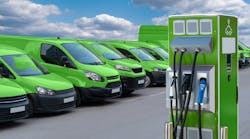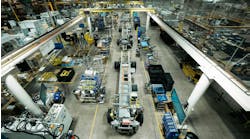INDIANAPOLIS—An estimated 20% of light- and medium-duty fleets could be zero-emission vehicles by 2030—even more for parcel and delivery fleets. The one-day Green Truck Summit ended up focusing more on how fleets will power electric and other ZE trucks years from now.
Much of the March 7 summit was spent reminding fleets in attendance to pick the propulsion that best fits their use case: hydrogen fuel cell, hybrid, natural gas, propane, biodiesel, and, yes, electric. Presenters included the keynote speaker, Cummins President and CEO Jennifer Rumsey, Giorgio Rizzoni, director of The Ohio State University Center for Automotive Research, and Andrew Wrobel, director of auto and mobility at Escalent, a behavioral research firm that focuses on how commercial vehicles are used.
See also: More Work Truck Week 2023 news from Indianapolis
The current “hype cycle” is all about battery-electric, Cummins’ Rumsey said in an exchange with the summit’s returning emcee, John Davis, who is creator, host, and executive producer of MotorWeek. Davis noted trends change, like how "biodiesel, you hardly hear about it today.” Several years ago, natural gas was all the rage.
With the hype for electrification comes questions about charging infrastructure: how to finance it, how to locate reliable power in a utility grid that is often strained, how to build power stations, how to and who should maintain and repair them, and how to expand stations when a carrier’s electricity needs grow. No fewer than four “Electric Foundations” breakout sessions during the March 7 summit, which kicked off NTEA's Work Truck Week 2023, got into the weeds to find these answers.
See also: Bottlenecks, infrastructure undermine alternative fuel trucks
Much of last year’s Green Truck Summit was spent on which electric vehicles fit fleets’ needs, or their use cases; this year was much about the “I” word. Rumsey, Rizzoni, and Wrobel all discussed infrastructure, careful not to favor one propulsion platform over another.
“We don’t see a single solution, we see all solutions,” noted Wrobel, whose presentation later at the summit was titled “The Electric Vehicle Balancing Act.”
“There is not one solution that will meet all these applications at the same time,” Rumsey added during her keynote address. Last year, Rumsey became the first woman to lead the power technology company in its more than 100-year history. Perhaps the three biggest recent announcements out of her company, which had revenue of more than $28 billion in 2022, all dealt with decarbonization and sustainability: its New Power business; its next X10 fuel-agnostic engine for 2026; the acquisition last August of commercial vehicle component maker Meritor, which in turn bought Siemens' Commercial Vehicle Business to aid Meritor in developing electric powertrains.
'Fuel-agnostic' summit, with focus on electric
Aside from the fuel-agnostic engine, Cummins has positioned itself to be a fuel-agnostic company, said Rumsey, who was introduced for her keynote March 7 by Davis, who noted that 800,000 light- and medium-duty commercial vehicles have been sold since this time last year, adding that “this conference will cover a great deal more than electrification, but you’ll hear a great deal about it.”
See also: A framework for choosing powertrains in the 'messy middle'
Much of the sustainability ink about Cummins lately has been about its fuel-agnostic platform, “which is interesting in that [it] has a lot of components common to multiple platforms,” she said, so the company is planning “different scenarios because no one can predict how adoption with these technologies will go.” The president and CEO added that most Cummins revenue still derives from traditional diesel-burning power technologies, but “there’s been a lot of growth in these new technologies. We’re continuing to evolve these new technologies in our portfolio.”






